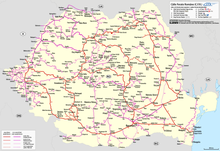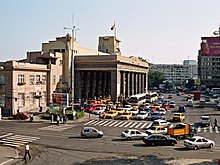Căile Ferate Române
The Căile Ferate Române , abbreviated CFR , is the state railway company of Romania .
history
The beginnings
The oldest railway line of today's Romanian railway network was built by the Austrians in the Banat , which at that time was crown land directly subordinate to the Vienna Ministry . The opening took place on November 15, 1857. This line connected the cities of Timisoara , Hatzfeld , Kikinda and Szeged over a length of 112 km. This reduced the travel time from Timisoara to Vienna to 36 hours. A year earlier, in 1856, the Banat Montanbahn was opened, which transported coal from Steierdorf-Anina to Basiasch. However, this railway line was partially dismantled after the Second World War. The first railway line on the territory of the old Kingdom of Romania was built from 1864 by a company under the leadership of the Englishman John Trevor-Barkley. It was opened on August 26, 1869 and connected the capital Bucharest with the southern border town of Giurgiu on the Danube. In 1866 Parliament awarded another concession to a private consortium led by the German Bethel Henry Strousberg , the good contacts with the Hohenzollern Prince Charles I . would have. This began with the construction of two routes that led from Bucharest on the one hand via Piteşti in the south-west of the country and on the other in the east and north-east to Buzău , Brăila , to the Danube port Galați and on to Roman in the north-east. In 1868 the large northern station was built in Bucharest for this purpose . The first part of this line, from Piteşti to Roman, finally went into operation on September 13, 1872. However, the construction of the western part was delayed by the founder crash . In the end it could still be built and extended to Vârciorova on the border with Austria-Hungary. This line was put into operation on May 9, 1878. This connection to the Hungarian rail network enabled the first Orient Express to run from Paris via Vienna, Budapest and Bucharest to Giurgiu in 1883 .
In the same period of time, another railway line was built in the northeast of what is now the national territory. In 1867 the Austrian Lemberg-Chernivtsi Railway received a concession from the consortium of Victor Ofenheim to extend the line in Galicia to Suceava in what was then Austrian Bucovina . In 1868 this company received permission from the Romanian parliament to continue building the line as far as Jassy in Moldova. This society was now called K. k. priv. Lemberg-Chernivtsi-Jassy railway company and was divided into an Austrian and a Romanian line. In 1871 the full route to Jassy was opened. Due to stock exchange speculation and mismanagement, however, there were construction defects that ultimately led to several serious train accidents, so that the Austrian part was placed under state administration on October 7, 1872.
The start-up crash that began on the Vienna Stock Exchange in 1873 finally brought the entire private railway industry in Southeastern Europe into dire financial difficulties. It was not until 1879 that the two connections to the Hungarian rail network could be put into operation, in the southwest to the private Austrian State Railway Company near Orșova and in the direction of Transylvania via the Predeal Pass to the Hungarian Eastern Railway . By a parliamentary resolution, the originally Strousberg'sche private railway from Vârciorova to Roman was nationalized in 1880 and the Căile Ferate Române (CFR) was founded for this purpose. After further scandals and accidents on the Romanian part of the Lemberg-Chernivtsi-Jassy Railway, this was also nationalized in 1888 and placed under the CFR. After Romania's territorial gains in Dobruja were in 1889, railway lines with a total length of 1377 km in the entire Romanian kingdom were under state CFR administration.
CFR in Greater Romania
After the collapse of the Habsburg Empire and the considerable territorial gains of Romania (parts of the Banat, Transylvania , Bukovina , Bessarabia , etc.), the railway network naturally expanded significantly. The first period of modernization began in the interwar period . For example, the first diesel locomotives were used. In addition, the gauge of the railway lines in Bessarabia had to be changed from broad gauge (typical for Russia , to which it belonged before 1918) to standard gauge (typical for Romania).

Socialist time
After the Second World War (in the 1950s and 1960s) the electrification of the main lines began, above all the line from Bucharest to Brașov ( Kronstadt ). In the 1970s, most steam locomotives disappeared from everyday use. In addition, the State Railways initially operated the Bucharest Metro , which opened in 1979 ; today the private joint-stock company Metrorex is responsible for this.
After the turn"
During the 1990s, the CFR experienced a difficult time, which was also associated with a lasting loss of image, in line with the country's general transformation difficulties after the fall of 1989. After major cuts were made in the administrative structures, the CFR were slowly able to overcome the economic low point of the 1990s.
CFR today
The majority of the traffic on the electrified routes is handled by the 060 EA series electric locomotives. The first ten machines were built by ASEA in Sweden. This type was then reproduced in large numbers under license by Electroputere in Craiova and also delivered to Yugoslavia and Bulgaria. In double track lines is legal operation. An alternating current of 25 kV / 50 Hz is used on electrified routes . At the beginning of 2003, the sensational acquisition of the modern, prestigious CFR train was made. The Siemens Desiro trains ( CFR series 96 ) are called “Săgeata Albastră” (“Blue Arrow”) and are preferably used on long routes, although they are actually intended for local traffic.
Train types
The CFR operates 3 train types: Regio (R), Interregio (IR) and Intercity (IC). The previously existing train types Personal, Accelerat and Rapid were abolished in 2011 as part of the standardization of European train types. The fares are very different depending on the type of train - a journey in the region costs half of a journey in the interregio.
Route network
The total length of the route network is 20,730 km; of which 3,292 km are electrified and 2,707 km are two-lane. However, in contrast to countries in Western Europe, it is slower to travel by train than by car. One reason for this is that, since 1989, there has hardly been any money for the maintenance of the network. The top speed on the main thoroughfares is only 100 km / h; in the past, speeds of around 120 km / h were often possible. The Bucharest – Constanța line is currently being expanded to 160 km / h. Since accession to the EU, subsidies have eliminated slow-travel routes, but the subsidies are far from being exhausted.
Train stations
In addition to Bucharest, important railway junctions with large passenger stations can be found in Ploiești (Ploiești Vest and Ploiești Sud stations), Arad , Constanța , Cluj-Napoca ( Klausenburg ), Brașov ( Kronstadt ), Craiova and Timișoara ( Timisoara ). Since 2014, with the support of the European Union, a number of train stations have been made accessible to disabled people . The program should be completed in 2020.
From the Bucharest North Railway Station ( Gara de Nord ) there are daily direct international connections to Belgrade , Budapest , Chișinău , Istanbul , Kiev , Moscow , Prague , Bratislava , Sofia , Warsaw and Vienna .
In freight traffic , the most important marshalling yards are the following (all classified in the highest category “ Triaje de rețea ”): Dej Triaj, Caransebeş Triaj, Simeria Triaj, Braşov Triaj, Adjud , Ploieşti Triaj and Bucureşti Triaj in Bucharest ; others are listed here .
CFR traction vehicles
CFR traction vehicles with German Wikipedia entries:
Narrow gauge railways in Romania
The Bosnian gauge of 760 millimeters dominated the Romanian narrow-gauge railways . The most famous narrow-gauge line in the country is the Wassertalbahn , which, as a forest railway, was subject to the state forest authorities and was therefore integrated into their railway company Căile Ferate Forestiere (CFF). The last narrow-gauge line of the CFR was the 2001 discontinued Wusch from Sibiu to Agnita , which is to be reactivated for excursions. The railway from Târgu Mureș to Band, which was reopened for charter trips in 2003 and which was operated by CFR on a regular basis until the 1990s, is no longer open after various thefts of small items. The only electric narrow-gauge railway in Romania was the meter-gauge local Arad – Podgoria railway, which was operated by the state railway between 1948 and 1983.
Well-known Romanian railway pioneers and railway workers
- Anghel Saligny (1854–1925), Romanian railway engineer, a. a. known for the design of the Anghel-Saligny Bridge
- Ion IC Brătianu (1864–1927), liberal politician ( PNL ) - a. a. Foreign Minister and Prime Minister , trained railway engineer
- Nicolae Malaxa (1884–1965), engineer and industrialist, builder of locomotives and express railcars
- Alexandru Pantazi (1896–1948), mathematician and scholar, professor at CFR University
- Vasile Luca or László Luka (1898–1953), communist politician of Hungarian origin
- Gheorghe Gheorghiu-Dej (1901–1965), Romanian communist politician, former president
- Gheorghe Apostol (1913-2010), communist politician and Ceaușescu rival
- Andrei Andreicuț (* 1949), Romanian Orthodox Archbishop of Alba Iulia , previously CFR engineer
Others
Rapid Bucharest and CFR Cluj are the two most successful Romanian railway sports clubs, internationally known primarily for their soccer teams . Rapid Bucharest was three times Romanian champion, most recently in 2003. CFR Cluj was also three times champion and made it into the Intertoto Cup final in 2005 .
swell
literature
- Romanian railways . In: Encyclopedia on the railway history of the Alps-Danube-Adriatic region. 2006.
- Felix Milleker : The Banat Railways. Their creation and development. 1847-1917. Kirchner, Weißkirchen 1927.
- Elmar Oberegger: The Banat - the nucleus of today's Romanian network. Contribution to the anniversary of 160 years of railways in Romania. Sattledt 2007.
- Elmar Oberegger: The individual countries. Sattledt 2007. (On the history of the railways in the Alps-Danube-Adriatic region 1).
- Fritz Stöckl: Railways in Southeast Europe. Yugoslavia, Greece, Romania, Bulgaria, Turkey. Bohmann, Vienna 1975, ISBN 3-7002-0431-X .
Individual evidence
- ^ Banat's historical chronology for the last millennium. century. www.genealogy.ro, accessed April 27, 2011
- ↑ A. Guenther, S. Tarkhov, C. Blank: Tram Atlas Romania 2004. Working Group focus tram e. V., Berlin 2004, ISBN 3-926524-23-5 , page 50
- ↑ Mikhai Ovidiu Ionut Mihai: Modernization of railway stations in Romania taking into account the interests often the People with limited mobility . In: OSJD Bulletin 1/2018, pp. 10-14.
- ↑ Information on Andrei Andreicuț at crestinortodox.ro accessed on January 15, 2016 (Romanian)






